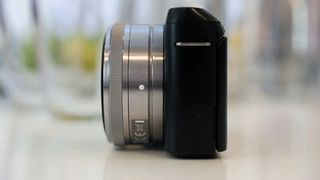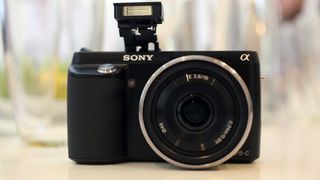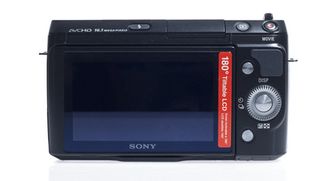Why you can trust TechRadar
Thanks to the large APS-C sized Exmor CMOS sensor, the Sony NEX-F3 sports a sensitivity range of ISO 200-16000, which should provide ample flexibility for taking pictures in a wide range of lighting conditions.
Sony's Bionz processor has been implemented to keep the camera responsive, which promises to help reduce noise in images' output by the sensor at high sensitivities and enable continuous shooting at speeds of up to 5.5 frames per second, with subject-tracking autofocus. The subject-tracking AF attempts to keep up with the closest subject in the frame, and should be great for keeping up with erratic subjects.
Even though this camera is the entry-level model, plenty of controls are included that should satisfy the needs of more experienced photographers. Manual, Aperture Priority, Shutter Priority and Program modes nestle alongside automatic scene programs and two fully automatic exposure programs.

The same Intelligent Auto mode found on previous models is still included alongside a new 'superior' auto program. This mode uses more of the Sony NEX-F3's features in an attempt to take the correct shot, including automatic scene detection and auto HDR.
Three metering modes are available, including 1200 zone evaluative, spot and centre-weighted metering and exposure compensation of plus or minus three stops, which can be used with raw and/or JPEG image formats when using one of the four creative manual exposure modes.
Exposure programs to suit all levels of experience are included. If the camera was handed to a novice, then the point and shoot automatic mode should help them to concentrate on taking pictures, whereas more advanced users may feel more at home with the classic Program, Manual, Aperture Priority and Shutter Priority exposure modes.

The usual array of automatic scene programs give a certain amount of control for novice users too. Two Sweep Panorama modes automatically stitch images taken as the camera is moved from left to right across a scene. One of these will also create a three-dimensional effect, which can be seen on compatible televisions via the built in mini HDMI interface.
Exposure readings are taken by the image sensor in either 1200 zone Multi-segment, Centre-weighted or Spot metering.
A 3-inch screen with a resolution of 912,600 dots can be rotated around 180 degrees for taking self portraits. When the screen is flipped around, a three second self timer automatically engages, making it much easier to ready yourself for shots taken at arms length.

The screen is clear and bright, thanks to its high resolution. Saying that, even though a good anti-reflective coating has been applied, the shiny surface of the screen can be difficult to see properly in very bright conditions.
High contrast scenes can be difficult to capture properly in one image, so Sony has included two features to help increase the range of tones captured. The simplest is the DRO Auto mode, which lightens shadows and darkens highlights in an image to create an impression of more detail.
The second is the HDR Auto mode, which takes three shots at different exposures and merges them, taking the light and dark information from each image. The results from this mode are good, retaining plenty of detail in highlight and shadow areas of images. Care needs to be taken to hold the camera steady when using this mode, otherwise errors can occur when the three images are merged.

Video recording in full high definition resolution is possible at frame rates up to 25 frames per second, or 50 interlaced frames per second in the popular AVCHD format. MP4 format is also supported at up to 25 frames per second. Aperture priority and manual exposure settings can be applied prior to recording, which can be useful for altering depth of field.
Stereo sound is recorded by a pair of microphones in the camera, but there is no facility to add a standard external mic via a 3.5mm jack or XLR connection for better sound quality. However, Sony's ECM-SST1 mic can be fitted to the accessory port on top of the Sony NEX-F3. Maybe some time Sony will offer an adaptor for this purpose? Such an adaptor will be met with a warm reception, should it ever materialise.
A tiny flash unit folds out of the top of the camera body on a flimsy looking spring-loaded arm. This flash isn't very powerful, but can be used at close distances for a little fill. The articulated arm supporting the flash doesn't always hold it completely straight. More often than not, the flash unit is tilted downwards by a noticeable amount, which can lead to uneven flash coverage when shooting at wide angles.
At close distances, the hood on the standard 18-55mm lens can shade part of the image area too, leading to unsightly shadows in images. No hotshoe is provided for attaching larger external flashguns or lighting accessories.

